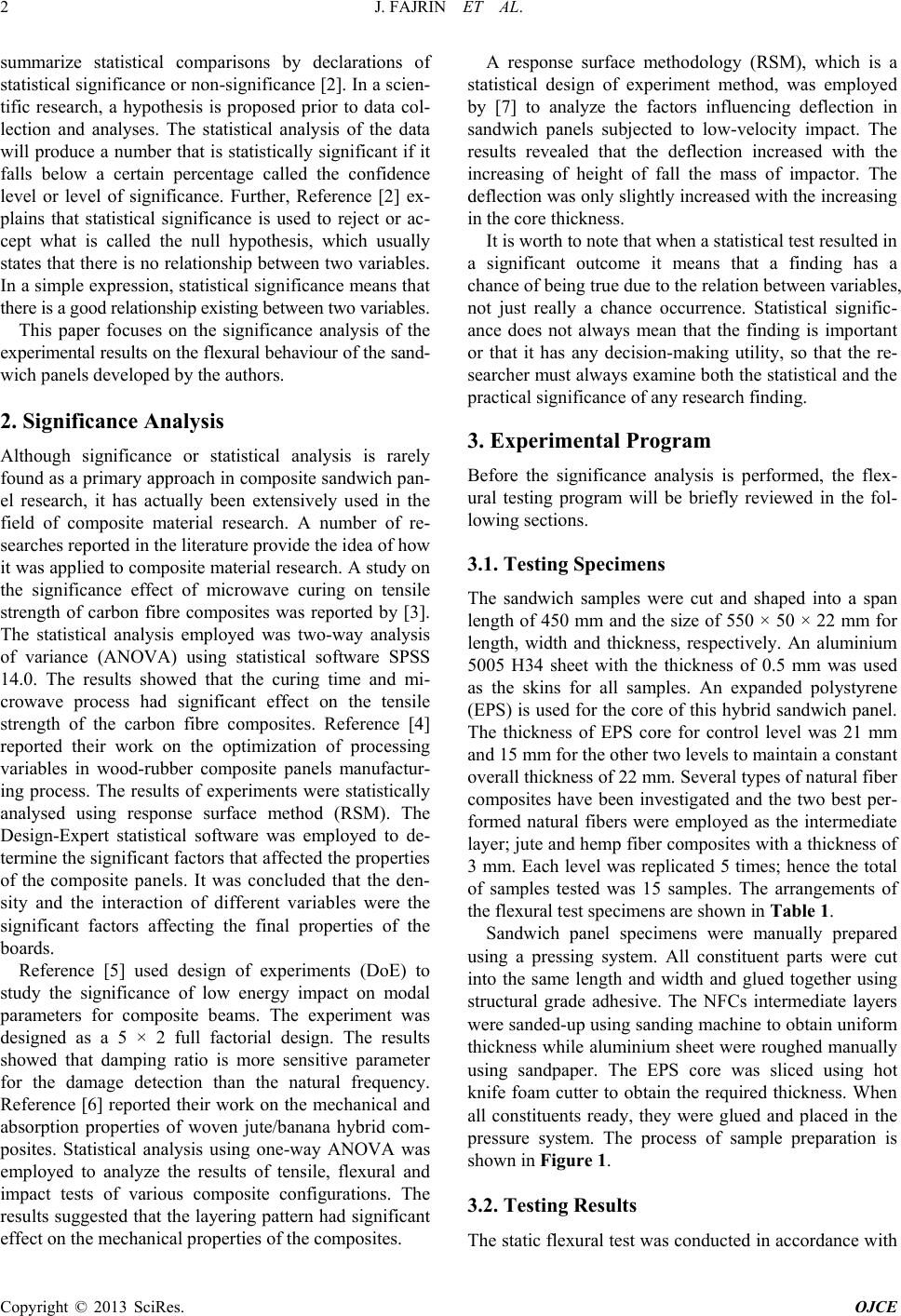
J. FAJRIN ET AL.
Copyright © 2013 SciRes. OJCE
summarize statistical comparisons by declarations of
statistical significance or non -significance [2]. In a scien-
tific research, a hypothesis is proposed prior to data col-
lection and analyses. The statistical analysis of the data
will produce a number that is statistically significant if it
falls below a certain percentage called the confidence
level or level of significance. Further, Reference [2] ex-
plains that statistical significance is used to reject or ac-
cept what is called the null hypothesis, which usually
states that there is no relationsh ip between two variables.
In a simple expression, statistical sign ificance means that
there is a good re lat ionshi p exis ti ng bet ween two variables.
This paper focuses on the significance analysis of the
experimental results on the flexural behaviour of the sand-
wich pane l s develope d by the authors.
2. Significance Analysis
Although significance or statistical analysis is rarely
found as a primary approach in composite sandwich pan-
el research, it has actually been extensively used in the
field of composite material research. A number of re-
searches reported in the literature provide the idea of how
it was applied to composite material research. A study on
the significance effect of microwave curing on tensile
strength of carbon fibre composites was reported by [3].
The statistical analysis employed was two-way analysis
of variance (ANOVA) using statistical software SPSS
14.0. The results showed that the curing time and mi-
crowave process had significant effect on the tensile
strength of the carbon fibre composites. Reference [4]
reported their work on the optimization of processing
variables in wood-rubber composite panels manufactur-
ing process. The results of experiments were statistically
analysed using response surface method (RSM). The
Design-Expert statistical software was employed to de-
termine the significant factors that affected the properties
of the composite panels. It was concluded that the den-
sity and the interaction of different variables were the
significant factors affecting the final properties of the
boards.
Reference [5] used design of experiments (DoE) to
study the significance of low energy impact on modal
parameters for composite beams. The experiment was
designed as a 5 × 2 full factorial design. The results
showed that damping ratio is more sensitive parameter
for the damage detection than the natural frequency.
Reference [6] reported their work on the mechanical and
absorption properties of woven jute/banana hybrid com-
posites. Statistical analysis using one-way ANOVA was
employed to analyze the results of tensile, flexural and
impact tests of various composite configurations. The
results suggested that th e layering pattern had significant
effect on the mechanical properties of the composites.
A response surface methodology (RSM), which is a
statistical design of experiment method, was employed
by [7] to analyze the factors influencing deflection in
sandwich panels subjected to low-velocity impact. The
results revealed that the deflection increased with the
increasing of height of fall the mass of impactor. The
deflection was only slightly increased with the incr easing
in the core thickness.
It is worth to note that when a statistical test res ulted in
a significant outcome it means that a finding has a
chance of being true due to the relation between variables,
not just really a chance occurrence. Statistical signific-
ance does not always mean that the finding is important
or that it has any decision-making utility, so that the re-
searcher must always examine both the statistical and the
practical significance of any research finding.
3. Experimental Program
Before the significance analysis is performed, the flex-
ural testing program will be briefly reviewed in the fol-
lowing sections.
3.1. Testing Specimens
The sandwich samples were cut and shaped into a span
length of 450 mm and the size of 550 × 50 × 22 mm for
length, width and thickness, respectively. An aluminium
5005 H34 sheet with the thickness of 0.5 mm was used
as the skins for all samples. An expanded polystyrene
(EPS) is used for the core of this hybrid sandwich panel.
The thickness of EPS core for control level was 21 mm
and 15 mm for the other two levels to maintain a constant
overall thickness of 22 mm. Several types of natural fiber
composites have been investigated and the two best per-
formed natural fibers were employed as the intermediate
layer; jute and hemp fiber composites with a thickness of
3 mm. Each level was replicated 5 times; hence the total
of samples tested was 15 samples. The arrangements of
the flexural test specimens are shown in Table 1.
Sandwich panel specimens were manually prepared
using a pressing system. All constituent parts were cut
into the same length and width and glued together using
structural grade adhesive. The NFCs intermediate layers
were sanded-up using sanding machine to obtain uniform
thickness while alu minium sheet were roughed manually
using sandpaper. The EPS core was sliced using hot
knife foam cutter to obtain the required thickness. When
all constituents ready, they were glued and placed in the
pressure system. The process of sample preparation is
shown in Figure 1.
3.2. Testing Results
The static flexural test was conducted in accordance with